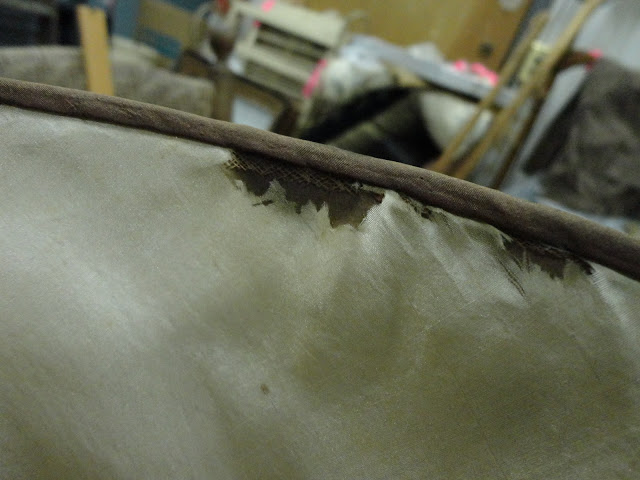(I did most of this entry about a month ago, so it makes reference to Things Happening and I'm just noting that they happened several weeks ago, not recently.)
At work I've moved completely into Putting Numbers On Things. This is in two categories: Finding Things' Original Numbers, and Giving Things New Numbers. The former is preferable, because it means you have some provenance and can prove the museum owns it, which is very important if you want to deaccession an item, but it can be pretty difficult, so I've been doing a lot of the latter.
One of the objects I gave a new number to on Friday was a bonnet quite like the Allie model in Mrs. Parker's Millinery and Mercantile. (Quite, quite like - the milliner says it's based off one in her collection, and there's another one that's almost identical to it at the Chapman, so that's interesting.) Since I was looking it over for any kind of number I noticed that it was in pretty bad shape, allowing you to see its inner workings, so of course I took out my camera. And then I looked in on a couple of the other bonnets to snap some shots there as well, just because.
The back, with the bow and the curtain. Those two lines on the curtain are ironed-down pleats, like tucks but not sewn. If you zoom in closer, you can see that the taffeta is positioned to be on the bias across the back. The vertical pleats on the back aren't very deep.
The bias-cut curtain is flatlined - after the tuck-pleating - with a very large gauge bobbinet. The hem is folded up and sewn only to the bobbinet, not through all the layers.
The off-white taffeta lining is coming apart, so you can see what's underneath. A wire runs all the way around the front edge to help control the shape, sewn to the paper interlining (which has kind of crumbled around here). These white running stitches would be hidden under the lining; I think they'd be pulled to gather the green taffeta just slightly enough to make it taut over the interlining. I think the thread is cotton.
Close-up of where the brim attaches to the crown. The crown is a very light buckram, pleated to shape, not covered.
The interior of the crown: buckram, cut and pleated to fit. I don't believe it was ever covered. It's smooth enough that hair wouldn't get caught in it, and it wasn't going to show.
The visible part of the brim here is the paper interlining - about as heavy as file folder material, I'd say. There are a lot of stitches holding the crown in shape, the brim's stitched right to it, and none of the stitches are neat. They don't need to be!
While the off-white taffeta lining covers a lot of the exciting stitching going on in the structural levels, the ribbon ties are attached with big, serious whipstitches.
And a different bonnet, same vintage:
The two have essentially the same brim shape. This one is bias-bound around the face edge, probably to cover that structural stitching. And the ribbon ties - very, very similar in color to the previous - are sewn tucked into the band that runs over the top of the bonnet, and under the edge of the curtain.
This bonnet was more interesting on the outside. Very thick piping surrounds the back of the crown, and a pleated self-fabric band covers the curtain attachment.
See, you can peek at the gathers underneath. (Eesh, my hands are really dry.)
The bottom of this curtain ruffle is actually piped, which gives it more body and matches the crown piping.
The attachment of the ribbon and the curtain to the brim.
Full interior shot. There's a piece of bias-cut gauze tacked over the brim attachment, and I think that that's the only lining that would have been inside the crown. This bonnet has a crown made in two pieces rather than a pleated one.
The hook and eye would hold the ribbon closed beneath the bow, which sounds like a really good idea to me.
The very edge of the brim. This lining is in much better shape, so this is the only place you can see the paper/board interlining, the same as in the last one.
skip to main |
skip to sidebar
New and exciting clothing collections. Beauty, fashion, vogue, glamour. Latest fashion news and tendencies. Fashion and beauty trends.
Search
Blog Archive
Popular Posts
2014 All Rights Reserved Fashion Beauty Glamour.

















